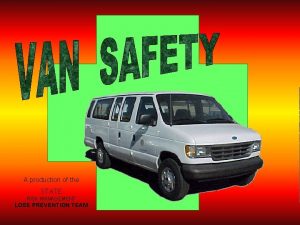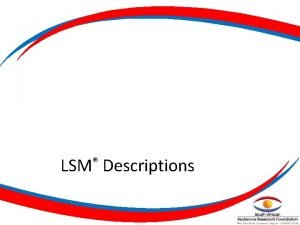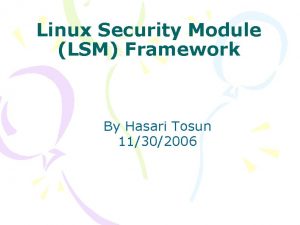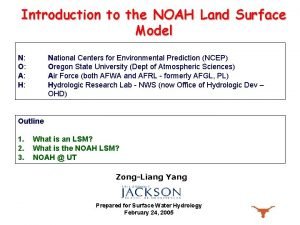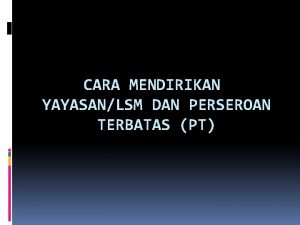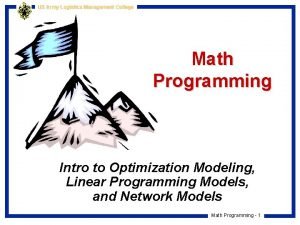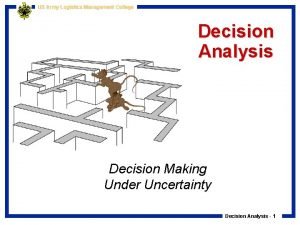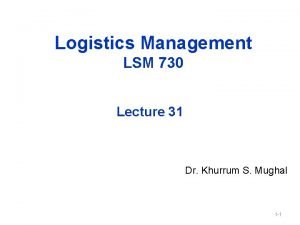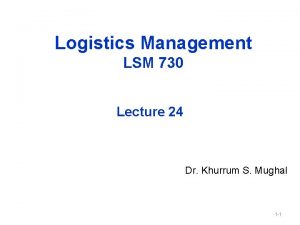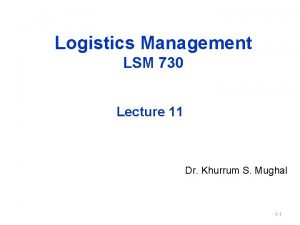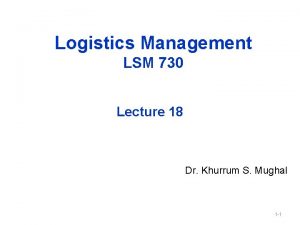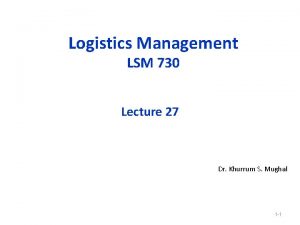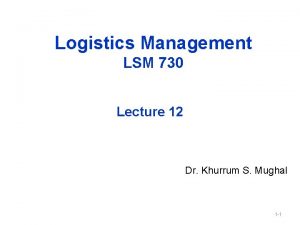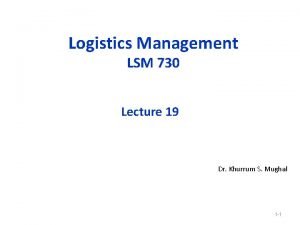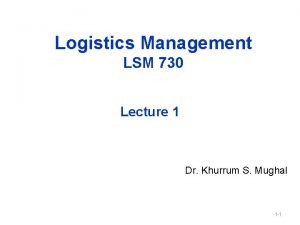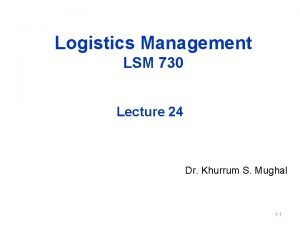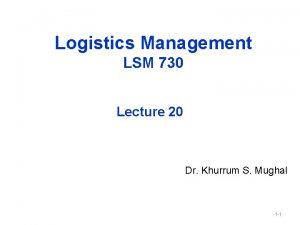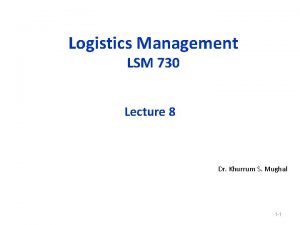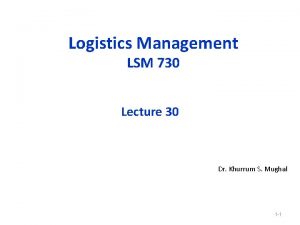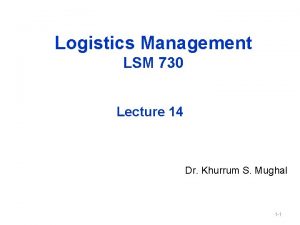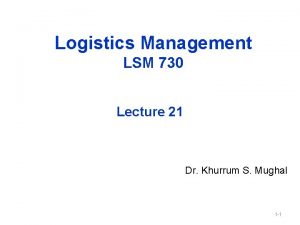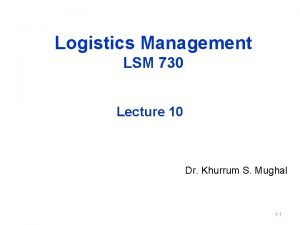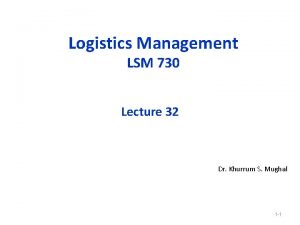Logistics Management LSM 730 Lecture 28 Dr Khurrum

















- Slides: 17

Logistics Management LSM 730 Lecture 28 Dr. Khurrum S. Mughal 1 -1

Consolidation Warehouse 10, 000 lb. A Similar to a merge-intransit facility Manufacturer A 8, 000 lb. B Manufacturer B 15, 000 lb. C Manufacturer C 40, 000 lb. A B C D Consolidation warehouse Customer 7, 000 lb. D Manufacturer D 11 -6

Distribution, Break Bulk, or Pool Point Warehouse Customer A LTL Manufacturer Low rate TL shipment Warehouse may or may not hold inventories CR (2004) Prentice Hall, Inc. Distribution warehouse LTL Customer B Customer C 11 -7

The Materials Handling System Materials Handling Functions · Loading and unloading · Movement to and from storage · Order filling Materials - Handling Considerations · Load unitization · Space layout · Storage equipment · Movement equipment CR (2004) Prentice Hall, Inc. 11 -4

An Automated Warehouse CR (2004) Prentice Hall, Inc. 11 -5

Economics of Storage/Handling Alternatives Leased warehousing Public warehousing Private warehousing, automated handling Cost to company, $ Private warehousing, pallet-forklift truck handling a 0 b c d Annual system throughput, cwt. Economical range for public warehousing. b Economical range for leased warehousing, manual handling. c Economical range for private warehousing, pallet-forklift truck handling. d Economical range for private warehousing, automated handling. a CR (2004) Prentice Hall, Inc. 11 -6

Virtual Warehousing • Don’t hold all inventories needed for sale in company’s warehouse • Ship selected items directly from suppliers • Reduces investment in inventories • Requires a first-rate order management system • May require sharing critical information with vendors CR (2004) Prentice Hall, Inc. 11 -7

Logistics/Supply Chain Organization A good organization structure does not by itself produce good performance-just as a good constitution does not guarantee great presidents, or good laws, or a moral society. But a poor organization structure makes good performance impossible, no matter how good the individual managers may be. To improve organization structure…will therefore always improve performance. Peter F. Drucker CR (2004) Prentice Hall, Inc. 15 -8

Organizing for Logistics/Supply Chain Management CR (2004) Prentice Hall, Inc. 15 -9

Objectives for Organization • Definitively defines responsibility, accountability, and good management • Collects people together in a meaningful way to management authority–essentials for achieve the goals of supply • Sets initial conditions so that proper cost tradeoffs can be realized • Facilitates the implementation of plans as well as the planning process • Aids administration CR (2004) Prentice Hall, Inc. 15 -10

Activity Fragmentation in the Supply Chain Responsibilities President Marketing • Distribution channels • Customer service • Field inventories • Revenue CR (2004) Prentice Hall, Inc. Finance • Cost of capital • ROI • Inventory carrying costs Operations • Supply alternatives and supply costs • Warehousing • Purchasing • Transportation 15 -4

Activity Fragmentation in the Supply Chain (Cont’d) Objectives President Marketing • More inventory • Frequent & short production runs • Fast order processing • Fast delivery • Field warehousing CR (2004) Prentice Hall, Inc. Finance • Less inventory Operations • Long production runs • Cheap order processing • Less warehousing • Lowest cost routing • Plant warehousing 15 -5

Activity Fragmentation in the Supply Chain (Cont’d) Reasons for fragmentation • Lack of understanding of key cost tradeoffs • Traditions and conventions • Other areas considered to be more important to the logistics • Organization structure can be in an evolutionary state firm than Benefits of fragmentation elimination • Encourages important cost tradeoffs to be effected • Focuses on an important, defined area by top management • Sets the structure within which control can take place CR (2004) Prentice Hall, Inc. 15 -13

Organizational Choices • Informal structure -Persuasion of top management -Coordinating committees -Incentive arrangements -Profit sharing -Cross charges • Semi-formal structure -Matrix organization • Formal structure -Line--creates value in products, therefore it has operating status -Staff--provides assistance to the line organization CR (2004) Prentice Hall, Inc. 15 -14

Logistics Matrix Organization CR (2004) Prentice Hall, Inc. 15 -8

Formalized, Centralized Organization Chief executive officer Vice-president Finance Vice-president Operations Vice-president Logistics Vice-president Marketing Manager Procurement Manager Warehousing and materials handling Manager Order processing and customer service Manager Transportation and packaging Manager Inventory and production scheduling CR (2004) Prentice Hall, Inc. 15 -16

Alliances and Partnerships Benefits • Reduced cost and lower capital requirements • Access to technology and management skills • Improved customer service • Competitive advantage such as through increased market penetration • Increased access to information for planning • Reduced risk and uncertainty CR (2004) Prentice Hall, Inc. 15 -17
 Ieee 730
Ieee 730 Trimble sps 730
Trimble sps 730 940 a yuvarlanan sayılar
940 a yuvarlanan sayılar Ars 28-730
Ars 28-730 170 f a c
170 f a c Permaglass me 730
Permaglass me 730 Lsm groups 1-10
Lsm groups 1-10 Lsm groups
Lsm groups 9dsmmwikhpi -site:youtube.com
9dsmmwikhpi -site:youtube.com Lsm framework
Lsm framework Convention de stage lsm
Convention de stage lsm Lsm
Lsm Cara mendirikan lsm
Cara mendirikan lsm Open source security
Open source security 01:640:244 lecture notes - lecture 15: plat, idah, farad
01:640:244 lecture notes - lecture 15: plat, idah, farad Us army logistics management college
Us army logistics management college Us army logistics management college
Us army logistics management college Performance cycle uncertainty
Performance cycle uncertainty



